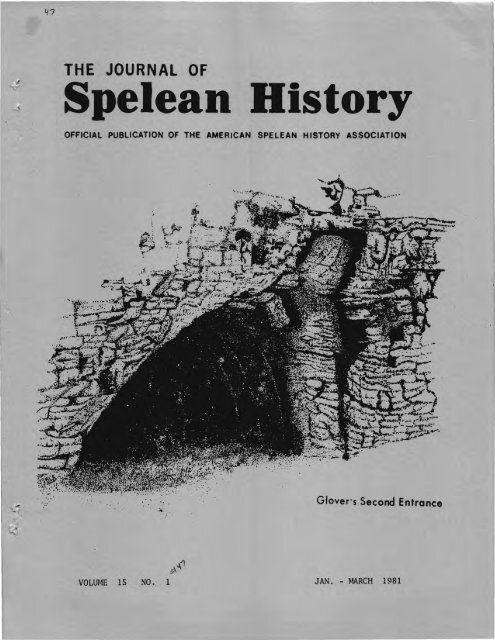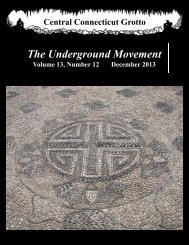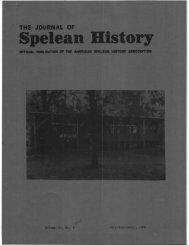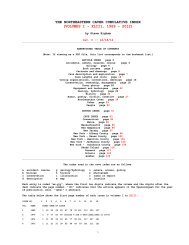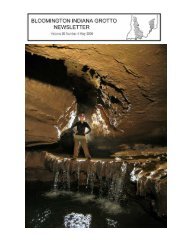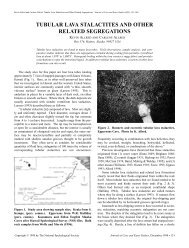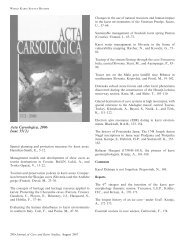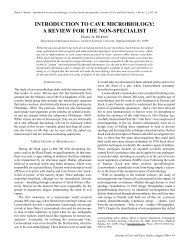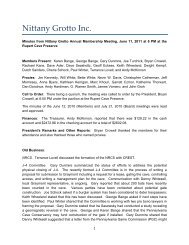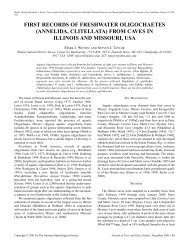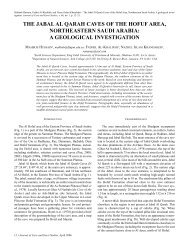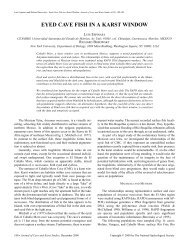047 (Jan-Mar 1981) - National Speleological Society
047 (Jan-Mar 1981) - National Speleological Society
047 (Jan-Mar 1981) - National Speleological Society
You also want an ePaper? Increase the reach of your titles
YUMPU automatically turns print PDFs into web optimized ePapers that Google loves.
47<br />
THE JOURNAL OF <br />
Spelean History <br />
OFFICIAL PUBLICATION OF THE AMERICAN SPELEAN HISTORY ASSOCIATION<br />
. '.. ~ -', . ,<br />
f;:," .. Glover'S Second Entrance<br />
......<br />
VOLlJr-1E 15 NO. 1 JAN. - MARCH <strong>1981</strong>
THE JOURNAL OF SPELEAN HISTORY<br />
* * * * * *<br />
Volume 15,<br />
No.1<br />
<strong>Jan</strong>uary - <strong>Mar</strong>ch <strong>1981</strong><br />
THE<br />
ASSOCIATION<br />
THE<br />
JOURNAL<br />
...<br />
The American Spelean History Association<br />
is chartered as a non-profit<br />
corporation for the study, dissemination<br />
and interpretation of spelean<br />
history and related purposes. All<br />
persons of high ethical and moral<br />
character who are interested in these<br />
goals are cordially invited to become<br />
members. Annual membership is $5.00;<br />
family membership is $6.00; and<br />
library subscriptions are $4.00.<br />
ASHA is the official history section<br />
of the <strong>National</strong> <strong>Speleological</strong><br />
<strong>Society</strong>, 1 Cave Avenue, Huntsville,<br />
Alabama 35810.<br />
THE<br />
COVER<br />
* * *<br />
Glover's Cave, Trenton, Ky. is the<br />
site of an archaeological study.<br />
The cave also has an interesting<br />
history. Several articles and a<br />
book has been published on the<br />
subject. An article on the cave<br />
appears in this issue of the<br />
JOURNAL. The drawing of the<br />
second entrance is taken from<br />
the Fall 1971 MVOR guide,<br />
produced by the Evansville<br />
Metropolitan Grotto.<br />
* * *<br />
The Association publishes the Journal<br />
of Spelean History on a quarterly<br />
basis. Pertinent articles or reprints<br />
are welcomed. Manuscripts should be<br />
typed and double-spaced. Submission<br />
of rough drafts for preliminary editing<br />
is encouraged. Illustrations<br />
require special handeling and arrangements<br />
should be made with the editor<br />
in advance. Photos and illustrations<br />
will be returned upon request.<br />
BACK<br />
ISSUES<br />
* * *<br />
Back issues of all volumes of the<br />
Journal are currently available from<br />
Jack H. Speece, 711 East Atlantic<br />
Avenue, Altoona, PA. 16602. Several<br />
of the early editions have been reprinted.<br />
Indexes for the first five<br />
volumes are also available upon<br />
request. All issues of Volumes 1<br />
to 7:2 are available on Microfiche<br />
from Kraus Reprint Company, Route<br />
100, Millwood, New York 10546<br />
* * *<br />
Official Quarterly Publication of the<br />
AMERICAN SPELEAN HISTORY ASSOCIATION<br />
* * *<br />
JOURNAL<br />
Editor:<br />
Asst.<br />
STAFF<br />
Jack H. Speece<br />
711 E. Atlantic Ave.<br />
Altoona, PA 16602<br />
Audrey N. Speece<br />
OFFICERS<br />
President: Kevin R. Downey<br />
V. Pres: Joel M. Sneed .<br />
Sec/Treas: Jack H. Speece<br />
"
ASHA 1980-<strong>1981</strong><br />
The As?ociation usually holds its annual meeting at the NSS Convent'<br />
each year. Slnce the Convention is being replaced with the Eighth Inte tl~n 1<br />
Congress of S 1 l' rna lana<br />
Hi t S ope eo ogy, no meetlng was held. Many of the members attended the<br />
s ory eS?lon ~eld Wedn~sday morning, July 22, 1980, on the campus of Western<br />
~en~upckY Unlverslty, Bow~lng Green, Kentucky. Due to the resignation of Presien<br />
aul Damon, the offlcers for <strong>1981</strong>-1982 are:<br />
President<br />
Kevin Downey<br />
Vice President<br />
Joel Sneed<br />
Editor<br />
Jack Speece<br />
Secretary/Treasurer<br />
Jack Speece<br />
Trustees<br />
Harold Meloy<br />
Russ Gurnee<br />
Cato Holler<br />
Jack Speece<br />
Balance 8/1/80 <br />
Income, <br />
Dues $547.00<br />
Subscriptions 28.00<br />
Back issues 21.00<br />
Interest .11 596.11<br />
705.58<br />
Expenses:<br />
Volume 13 #3 99.32<br />
Volume 14 #2/3 350.00<br />
Covers (back issues & Vol.12) 56.28<br />
Postage 47.50<br />
Bank charges 6.00 559.10<br />
Balance 8/1/81 $146.48<br />
THIRD ANNUAL<br />
PETER M. HAUER AWARD<br />
Anne Whittemore<br />
The Peter M. Hauer Spelean History Award for <strong>1981</strong> was presented at the<br />
NSS Convention in Bowling Green, Kentucky to Anne Whittemore for "The History<br />
of the Virginia Region: 1940-1970". The book itself is a collection of stories,<br />
p~ot~g:aphs a~d recollections of the people who caved and frolicked through the<br />
Vlrglnlas durlng the youth and adolescence of organized caving. The histories<br />
of individual grottos are included and the origins of the many traditional gatherings<br />
(for which the VAR is famous) are told. The evolution of cave rescue<br />
groups is even described. Quite naturally, the book has a lot of appeal to those<br />
who cave or have caved in the area, but that appeal is broadened by the fact that<br />
much of the early NSS history was made in what became the Virginia Region.<br />
Anne Whittemore (NSS 6879 FL), who lives in Johnson City, Tennessee with<br />
husband Whitt and son David, began caving in 1959 while attending the University<br />
of <strong>Mar</strong>yland. During the 1960s and early 1970s she spent countless weekends surveying<br />
caves and ridgewalking in Southwest Virginia for the Virginia Cave Survey<br />
and in the later 1970s in eastern and middle Tennessee for the Tennessee Cave<br />
Survey. Anne has served in an official capacity at one time or another for the<br />
Potomac <strong>Speleological</strong> Club, the VPI Grotto, the Holston Valley Grotto and the<br />
Virginia Region. She was also chairman of the NSS Membership Committee for<br />
.. several years and co-chaired the Old Timers' Reunion in 1979 and 1980. Anne<br />
has been editor of The Potomac Caver (PSC), The Tech Troglodyte (VPI), and<br />
worked extensively on the VAR's Region Record. She was awarded an NSS Fellow<br />
in 1974 and received the Carnegie Museum's Outstanding Caver Award in 1977.<br />
Anne has a BA in Geography from the University of <strong>Mar</strong>yland and a Masters in<br />
Library Science from Virginia Polytechnic Institute and State University.<br />
JOURNAL OF SPELEAN HISTORY 3
A GAZETTEER OF THE UNITED STATES OF AMERICA<br />
John Hayward<br />
(The Gazetteer was printed in 1853 in Hartford, CT, and contained several<br />
interesting reports on caves. This material was located by Gary Pipher.)<br />
p. 649. MADISON'S CAVE, VA.<br />
This cave is situated in the vicinity of Weir's Cave, and somewhat<br />
resembles that remarkable curiosity. It is, however, much less<br />
extensive, not exceeding 300 feet.<br />
pp. 650-652<br />
MAMMOTH CAVE, KY.<br />
This stupendous wonder of nature is situated in Edmonson co.,<br />
about 90 miles S. from Louisville, and about equally distant, in a<br />
N.E. direction, from Nashville, Te. A large and commodious hotel<br />
has been erected, two or three hundred paces from the mouth of the<br />
cave, for the accommodation of visitors. The tourist leaves the<br />
stage road about 6 miles from the entrance to the cave, and passes<br />
. through some of the most romantic and beautiful scenery in reaching<br />
this public house, where he finds every thing provided to render his<br />
visit agreeable and instructive. It is only within a few years that<br />
this cave has been very extensively explored; and it is still supposed<br />
that but a small part of it, in comparison with the whole, has ever<br />
been trodden by the foot of man. It has been estimated that the length<br />
of all the different avenues and branches, when added together, would<br />
make more than 600 miles. As far as known, there are in the cave 246<br />
avenues, 47 domes, 8 cataracts, and 23 pits. The darkness, deeper than<br />
that of the blaCkest midnight, which pervades these subterranean recesses,<br />
and which is little more than rendered visible by the torches<br />
which the visitors carry with them, renders it difficult for the spectator<br />
to form any thing like an adequate idea of its vast dimensions,<br />
its great heights and depths in the different apartments, and of the<br />
singUlarity and beauty of the natural decorations they contain. The<br />
recent attempt of an adventurous artist, however, to obtain drawings<br />
of a number of the different avenues, halls and chambers, for the purpost<br />
of illustrating the hidden wonders of this natural phenomenon to<br />
the eye by the aid of the beautiful illusion of the moving panorama,<br />
has been, in a great degree, successful. The different parts of the<br />
cave selected for this purpose were illuminated by hundreds of lights,<br />
placed at different points, so as to give the most powerful and just<br />
effect to the ever-varying perspective within.<br />
Immediately upon entering the mouth of the cave, the visitor<br />
perceives a sensible change in the temperature of the atmosphere,<br />
which is that of 59 0 Fahr., and remains so uniformly, winter and<br />
summer. No impure air exists in any part of it; decomposition and<br />
putrefaction are unknown; and combustion is perfect. Visitors going<br />
in and out are not liable to contract colds; but, on the contrary,<br />
colds are commonly relieved by a visit to the cave. No reptiles of<br />
any description are found here. It is a curious fact that fish without<br />
eyes have been caught in the rivers of this cave. They have been<br />
dissected by skillful anatomists, it is said, who declare that they<br />
are without the slightest indication of an organ similar to the eye,<br />
and also that they possess other anomalies in their organization interesting<br />
to the naturalist. These fishes are from 3 to 6 inches in<br />
length. Specimens of them are found in most of our collections of<br />
natural history.<br />
The cave is also inhabited by two species of rats and a species<br />
of crickets, neither of Which partake of the peculiarity of the fishes,<br />
--of the want of eyes,--for in both of these animals that organ is very<br />
largely developed. These rats are ~hite and very. large. Pro~essor<br />
Agassiz has some specimens of them ln the col~ectl0n at Cambrl~ge. In<br />
the winter, millions of bats find here a restlng-place well sUlted to<br />
their wants.<br />
During the last war with England, a saltpetre manufactory was<br />
established in this cave; and, although it was discontinued in 1815,<br />
wheel tracks are still to be seen as clear and distinct as if made<br />
yesterday. The guides also point out corn cobs which were brought<br />
into the cave at that time, and which are perfectly fresh and sound.<br />
The waters of the cave are of the purest kind; and, besides the<br />
Vol. 15 No. 1 4
springs and streams of fresh water, there are one or two sulphur springs.<br />
~here are stre~s, lakes, and waterfalls of sufficient width and depth to<br />
ompare well w~th those of the world above ground. Some of these rivers<br />
as they are called, are navigated by boats of sUfficient size to carry 12<br />
persons; and one, of them, called the Echo, is said to be broad and deep<br />
enough, at all t~mes, to float the largest steamers. The rivers of the<br />
Mammoth Cave we~e never c:osse~ til~ 1840. Some of them flow in deep<br />
channels! the s~des of wh~c~ r~se hlgh above their ordinary level. After<br />
heavy ra~~s, they are somet~mes swollen so as to rise more that 50 feet.<br />
At ~U~h t~mes the s~r:ams, and especially the cataracts, of the caves,<br />
e~~b~t a most terr~f~c appearance. Great exertions have been made to<br />
d~scover th: source~ of,thes: streams, and where they find their outlets.<br />
yet they st~ll rema~n, ~n th~s respect, as much a mystery as ever.<br />
"Darkly thou glidest onward, <br />
Thou deep and hidden wavel <br />
The laughing sunshine hath not looked <br />
Into thy hidden cave." <br />
~he different apartments and passages of this wonderful subterranean<br />
labyr~nth have many of them received names, from their resenblance, more<br />
or less real, to the most celebrated interiors and decorations of architectural<br />
design. A few only can be here described.<br />
At the Cave House, erected near the entrance by Dr. Croghan, the<br />
late proprietor of this wonder of the world, those visiting the cave<br />
are supplied with lights, guides, and whatever else may be required ·<br />
for their expedition. The air of the cave, as you enter, gives a<br />
pleasant sensation of refreshing coolness. As you continue descending<br />
some irregular stone steps, the daylight fades and the gloom deepens.<br />
Nothing is heard save your own footsteps, and the sound of the waters<br />
leaping from a precipice over your head and falling on the rocks below.<br />
A beautiful stream of water falls over the mouth of the cave, as one<br />
writer has remarked, as if it were the remnant of a graceful curtain,<br />
which had formerly concealed this wonder from the gaze of man. Looking<br />
back towards the orifice, the light of the external day appears dim, as<br />
if it were the twilight of evening. Looking before you, if looking it<br />
may be called,--what a world of darknessl With all your torches how<br />
little can be seenl A strange sensation comes over you, as with hesitating<br />
step you proceed.<br />
The first great expansion of the cavern which you enter is the<br />
Great Vestibule, an immense hall, covering an area of an acre and a<br />
half, with a dome, lost in the darkness, 100 feet high, unsupported<br />
by a single pillar. By kindling a fire at this spot, the vast dimensions<br />
of the chamber may be faintly discovered. "Far up above your<br />
head," says one, "is seen the gray ceiling rolling dimly away like a<br />
cloud, and many buttresses bending under their weight begin to project<br />
their enormous masses from their shadowy wall." Two avenues lead out<br />
of this hall, at opposite extremities, which are about 100 feet wide<br />
and 500 feet long, with roofs as flat and smooth almost as if finished<br />
by the mason's trowel. About half a mile farther on, you pass the<br />
Kentucky Cliffs, so called from their resemblance to the famous cliffs<br />
on the Kentucky River. About half a mile beyond these is the Church,<br />
which is )00 feet in circumference, and its ceiling 6) feet high. A<br />
huge protuberance of the rock on one side serves the fancy for a pulpit,<br />
and a recess in the wall, in a corresponding position, serves for a<br />
gallery. From this hint of nature, religious worship has more than<br />
once been celebrated here. Concerts of music have been held here,<br />
which have been said to produce singularly fine effects. After leaving<br />
the Church, a passage leads off at an acute angle from the main<br />
cave to the Gothic Avenue, which is nearly 50 feet wide, 15 feet high,<br />
and about 2 miles in length. The ceiling of this avenue is so smooth<br />
and white that it is difficult to believe that the trowel of the mason<br />
has not been used upon it. A good road extends through its entire length,<br />
and so pleasant is the temperature, purity, and salubrity of its atmosphere,<br />
that it has been selected as a most desirable promenade for invalids, who<br />
have sometimes resorted to this cave for their health. In one of the recesses<br />
of this avenue were to be seen, as late as 181), two mummies in a<br />
good state of preservation, one of which was a female, in a sitting posture<br />
with arms folded, and having before her various articles of her<br />
ward~obe. When, or by whom, these remains were placed in this dark and<br />
silent sepulchre, is of course unknown. ,A,little f~rther ?n in this<br />
direction are the Registry Rooms, the celllng of whlch, belng perfectly<br />
white and smooth, serves as the register of the cave. Thousands of names<br />
JOURNAL OF SPELEAN HISTORY 5
have. been traced upon it with the smoke of the torches. Next is the<br />
Goth1c Chapel, a hall of almost overwhelming grandeur, elliptical in<br />
form, and 80 feet long by 50 in width. Immense stalagmites have been<br />
formed at each end, which almost close the entrance. There are also<br />
two rows of smaller pillars, extending from the ceiling on each side<br />
of t~e wall through its entire length. These impart to it, when strongly<br />
l1ghted up, the grand and solemn effect of a Gothic cathedral. Near<br />
this place is Brewer's Studio, a small room to which this name has recently<br />
been given by Mr. Brewer, author of the celebrated Panorama of<br />
the Mammoth Cave, from whose descriptions many of these notices have<br />
been compiled. He finished many of his sketches in this room. One or<br />
two other points of curious interest, such as the Devil's Arm-chair and<br />
the Lover's Leap, bring you to the termination of this Gothic Avenue.<br />
Returning back to the main cave by another route, of more than a<br />
mile, through uninteresting scenery, and proceeding onward with this<br />
grand gallery, you soon reach the Star Chamber, one of the most brilliant<br />
apartments in the whole cave, and called by this name from the<br />
myriads of glittering points reflecting the light of the torches from<br />
t~e darkness overhead. The resemblance here to the splendid canopy of<br />
n1ght is very perfect. Further on, the Chief City, or Temple, is formed<br />
by an immense dome, which rises 120 feet high, and covers an area of<br />
2 acres. It exceeds in size the Cave of Staffa, and rivals the celebrated<br />
vault in the Grotto of Antiparos. In passing through it from<br />
side to side, the dome appears to follow the spectator, like the sky<br />
in passing from place to place on the earth. In comparison with this<br />
dome of nature's rearing, the most celebrated of human structure sink<br />
into insignificance. There are, however, other domes in this wonderful<br />
cave, which, for height and extent, are even more extraordinary than<br />
this. Such is that, especially, which is called the Mammoth Dome.<br />
This dome of domes is nearly 400 feet above the floor of the room which<br />
it covers. Its elevation has been carefully determined by a competent<br />
civil engineer.<br />
It would be impossible, within the limits of this article, to describe<br />
in detail the many objects of curiosity and scenes of grandeur<br />
which are to be found in the apparently interminable recesses of the<br />
Mammoth Cave. The names of the principal apartments, not already mentioned,<br />
will serve, by the aid of the foregoing descriptions, to suggest<br />
to the imagination of the reader some idea of their most impressive characteristics.<br />
Such are the Giant's Coffin, the Labyrinth, the Cascade,<br />
Gorin's Dome, the Bottomless Pit, the Winding Way, the Bandit's Hall,<br />
Great Relief Hall, River Hall and Dead Sea, Natural Bridge over the<br />
River Styx, (80 feet high,) Pass of EI-Ghor, Crogan's Hall, City of<br />
the Tombs, Saint Cecilia's Grotto, Silliman's Avenue, Great Western<br />
Vestibule, <strong>Mar</strong>tha's Vineyard, Snowball Room, the Holy Sepulchre,<br />
Cleveland's Cabinet, Serena's Harbor, Fairy Grotto, Paradise, and<br />
others of a hardly less remarkable character.<br />
To select one only from this list of wonders for the conclusion<br />
of our descriptions, we would offer the remarks of an intelligent<br />
clergyman, who lately paid a visit to the cave, upon that splendid<br />
hall known by the name of Cleveland's Cabinet. "The most imaginative<br />
poet," says this gentleman, "never conceived or painted a palace of<br />
such exquisite beauty and loveliness as Cleveland's Cabinet. Were the<br />
wealth of princes bestowed on the most skillful lapidaries, with a view<br />
of rivalling the splendors of this single chamber, the attempt would be<br />
vain. The Cabinet was discovered by Mr. Patten of Louisville and Mr.<br />
Craig of Philadelphia, accompanied by Stephen, the guide, and extends<br />
in nearly a direct line about it miles, (the guides say 2 miles.) It<br />
is a perfect arch, of 50 feet span, and of an average height of 10 feet<br />
in the centre--just high enough to be viewed with ease in all its parts.<br />
The base of the whole is carbonate (sulphate) of lime, in part of a<br />
dazzling whiteness and perfectly smooth, and in part crystallized, so<br />
as to glitter like diamonds in the light. Growing from this, in endlessly<br />
diversified forms, ~s a substance resembling selenite, tran~-.<br />
lucent and imperfectly lam1nated. Some of the crystals bear a str1k1ng<br />
resemblance to branches of celery; others, a foot or more in length,<br />
have the color and appearance of vanilla cream candy; others are set in<br />
sulphate of lime in the form of a rose; and other~ roll out fr?m t~e<br />
base in forms resembling the ornaments on the cap1tal of a Cor1nth1an<br />
column. Some of the incrustations are massive and splendid, others are<br />
as delicate as the lily, or as fancy work of shell or wax. Think of<br />
traversing an arched way like this for a mile and a half; and all the<br />
wonders of the tales of youth--Arabian Nights, and all--seem tame,<br />
Vol. 15 No. 1 6
I<br />
compared with the living, growing reality. Here and there, through the <br />
whole extent, you will find openings in the sides, into which you may <br />
thrust the person, and often stand erect, in little grottoes, perfectly <br />
incrusted with a delicate, white substance, reflecting the light from a <br />
thousand different points. All the way you might have heard us exclaim<br />
ing, Wonderful! wonderful! 0 Lord, how manifold are thy works I " <br />
The route by which this cave is commonly reached is by the daily line of<br />
U. S. mail stages from Louisville to Nashville, over a very good turnpike<br />
road. The stock has been subscribed for a railroad between these places,<br />
and in a few years the cave will be rendered much easier of access •<br />
.p. 659<br />
NICOJACK CAVE, GA.<br />
This vast cave is situated in the N. W. extremity of the state, having<br />
its entrance about 20 miles S. W. of the Lookout Mountain, and half a mile<br />
from the S. bank of the Tennessee. The width of the entrance is 25 feet<br />
in height. The Students' Cave, first explored by the students of Mercer<br />
University in 18~hich has its entrance about 4 miles distant, in Tennessee,<br />
is supposed to be connected with this.<br />
The interior passages and apartments of these caves afford much both to<br />
astonish and delight the visitor. Spacious rooms and lofty domes, tall<br />
columns and glittering pendants from the ceilings, arches and resemblances<br />
to architectural facades, entablatures, and other decorations, consitute<br />
a succession of interesting objects, the extent of which is not definitely<br />
known. The railroads from Charleston and Savannah to the Tennessee River<br />
afford a ready communication with the region in which these caves are<br />
situated.<br />
p. 673 wEIR'S CAVE, VA.<br />
This is considered as one of the most beautiful caverns in the world.<br />
It extends about 2500 feet in length, and is divided into a number of<br />
apartments, differing in size and in the beauty of their decorations.<br />
Some of the most extensive have received the names of ''Washington Hall,"<br />
"Congress Hall," "Solomon's Temple," "Organ Room," "Deacon's Room," &c.<br />
The walls consist of the most beautiful crystallized carbonate of lime,<br />
or calcareous spar. That which gives this cavern such a peculiar splendor<br />
is the great variety in form and color of the crystals with which its<br />
walls and ceilings are adorned, as they reflect the light of the torches<br />
with which these subterranean recesses are explored. Some of the apartments<br />
seem to be furnished, as it were, by the upholsterer, with hangings<br />
of rich and graceful drapery, formed by thin sheets of the same kind of<br />
incrustation, and from the lofty roof of one of the halls there is a sheet<br />
of this description which appears as if floating in the air, to which the<br />
appellation of "Elijah's Mantle" has been given.<br />
The person who has the charge of this cave gives every requisite attention<br />
to the accommodation of visitors. It lies 17 miles N. E. from<br />
Staunton.<br />
EARTHWATCH, 10 Juniper Road, Box 127, Belmont, Mass. 02178 is conducting an expedition to<br />
Timbiteni for the study of The Cave of the Beer Pots. The hope that the cave will have a<br />
dense array of archaeological debris beneath modern surface that will include artifacts of<br />
Middle Stone Age date. Timbiteni is verginal, with all its secrets still intact. It would<br />
appear that the cave is similar to nearby Boulder Cave which has already produced many<br />
interesting items. Two week trips will begin on June 28, 1982 and will end on Aug. 22.<br />
Students will be under the supervision of Dr. David Price Williams from the University<br />
of Ldndon. Individule's cost for a two week study is $1235.<br />
JOURNAL O.F SPELEAN HISTORY 7
GLOVER'S CAVE, KENTUCKY<br />
MVOR (1971)<br />
The Glover property was first surveyed in 1782, when two brothers-in-law<br />
bought a 2,OOO-acre tract of land, Captain John Montgomery and James Davis<br />
brought their families from Pittsburgh in a boat down the Ohio and Cumberland<br />
Rivers, then up the Red River and West Fork until they found the spring and cave<br />
entrance.<br />
The two families lived in the cave while they built a blockhouse by the<br />
spring for protection against the Indians. Later they built a log cabin at the<br />
top of the hill, which has been added to at various times, and is the present<br />
home of the Glovers.<br />
Montgomery's son was killed and scalped by Indians on Montgomery Creek and<br />
a limestone slab marks his grave at the site. Jefferson Davis was born here two<br />
weeks before his family moved to Fairview, Kentucky.<br />
As the population of the county grew, James Davis became dissatisfied,<br />
sold his land in 182) to Dr. John Francis Bell, and moved to a more unsettled<br />
part of the country. Bell built the office next to the house to carryon his<br />
practice. There is no record of what happened to Montgomery.<br />
In 1884, Robert D. Glover, father of Armstead and Robert, purchased the<br />
farm from Bell. "The damned Yankees ruined us in Virginia," said Armstead, "so<br />
we moved to Kentucky." During the early years of the Glover ownership, the cave<br />
floor was covered with sawdust for the square dances held there.<br />
An Indian village site, stone grave cemetery, and three mounds located<br />
near the cave were first studied in 1926 by Dr. W. S. Webb and Prof. W. D.<br />
Funkhouser from the University of Kentucky.<br />
The cave was never researched before Raymond D. Vietzen, author-archeologist,<br />
visited the area beginning 1941. He published his findings about Glover's<br />
Cave and the area in 1956 in "Saga of Glover's Cave."<br />
A few caves and rock shelters in the area have been used very little, but<br />
others and especially Glover's contain large quantities of ashes, kitchen midden,<br />
and other artifacts.<br />
In the Glover's Cave region, especially in the area east of the cave<br />
entrance, there is a near-classical development of karst topography. All obvious<br />
landscape features are controlled, or influenced, by solution. The sinkholes of<br />
the region are numerous. The cave is located in the Hammacksville 7! minute<br />
topographic quadrangle.<br />
As you explore Glover's Cave you will see innumerable joints and occasional<br />
evidence of faulting. It is possible, even probable, that the main passages of<br />
the cave line up with the regional structural framework. The Cave is developed<br />
in the Ste. Genevieve Limestone, deposited during the Mississippian Period, a<br />
brief ))5,000,000 years ago.<br />
The mineralogy of the cave seems simple. Calcite and Gypsum form surficial<br />
formations throughout the cave. A rapid reconnaissance failed to reveal anything<br />
exotic. There are many different stratas containing fossils, chert, and Oolitic<br />
limestones. The area consists of widely spaced faults and very well developed<br />
joints.<br />
The main entrance to Glover's Cave is a large opening into a relatively<br />
small bluff at the end of a draw. A walking passage winds past a few side passages<br />
and leads )00 feet north to a secondary entrance, also in a small bluff.<br />
A stream flows into the secondary entrance from a third entrance, 100 feet northeast.<br />
This is the water supply for the Glovers and should not be disturbed.<br />
The first 2,000 feet of passage running east from the main entrance is<br />
large with a flat ceiling and a relatively level floor, except for intermittent<br />
rimstone dams; this passage is dubbed the Lincoln Tunnel. A side passage to the<br />
left near the end of this portion of the cave goes about )00 feet to a small pool.<br />
Just beyond the Lake Room passage, and at a pOlnt where the character of the cave<br />
Vol. 15 No. 1 8
changes abruptly, is a small lower level passage to the left leading a short distance<br />
to a small domed grotto with a large brown f1owstone formation. The passage<br />
becomes larger with large high ledges on both sides of the meandering muddy<br />
intermittent stream. A small hands-and-knees crawl extends about 700 feet to the<br />
left from the upper part of the first series of ledges, just past the grotto.<br />
After another 700 feet, there is a large room with breakdown scattered<br />
throughout. A small tight corkscrew passage extends at least 700 feet from the<br />
lower right hand side of this room; the main passage continues through or over ,<br />
breakdown a short distance to the Saddle Rock overlooking a small pool. A slippery<br />
path skirting the edge of the pool leads to a sandy belly crawl which goes<br />
about )0 f€et to the base of the first chimney. The chimney goes about 25 feet<br />
up to a small plateau with a low ceiling, beyond which is more large passageway.<br />
uneven, muddy, and interspersed with crumbly breakdown.<br />
About 75 feet from the beginning of the large passageway, a small. tight.<br />
winding passage goes about a hundred feet down and to the right. The main passage<br />
continues 1,200 feet to the end of this large passage area. A small crawl<br />
to the right and then up, goes past a small pit into a large room; a crawl from<br />
the far side of the room leads about 100 feet to a second chimney. Another 25<br />
foot climb leads to more large passage.<br />
About 1,200 feet farther is the helictite passage, with brown he1ictites<br />
filling the entire left wall. This is followed by the Beauty Parlor which contains<br />
a few small speleothems. Another 1,000 feet of wet muddy low passage leads<br />
to a siphon which appears to be the end of the cave.<br />
JOURNAL OF SPELEAN HISTORY 9
'. f<br />
.. ,....<br />
.<br />
, " , ' ..,<br />
"<br />
... ' #<br />
'=:".... . ._~ ."""'.<br />
, t<br />
.. ~ ..:. . . .<br />
".<br />
j.<br />
..<br />
·'
STEPHEN L. BISHOP<br />
1821 - 1857<br />
~xplorer<br />
and Guide<br />
Mammoth Cave<br />
Stephen Bishop, a legend in his own time, has become a noted spelean<br />
folkhero. Some have credited him with the discovery, eXploration<br />
and mapping of Mammoth Cave. These, howeyer, are merely legends<br />
told by the early guides to make the attraction more exciting.<br />
Rivalry between the white and black guides helped to expand on<br />
Stephen's achievements over the years. This provided a sense of<br />
pride among the blacks who at that time were greatly suppressed<br />
when above ground by such organizations as the "Regulators".<br />
During the years Stephen served as guide, those who wrote about<br />
the cave would always mention him by name. He was not considered<br />
as a slave underground but was greatly respected. His owner<br />
described him as ..... trustworthy and reliable, he was companion<br />
able, he was a hero, and he could be a clown. He knew a gentleman<br />
or a lady as if by instinct. He learned whatever he wished without<br />
trouble or labor." Joseph Parrish described him as "the Columbus<br />
of the underground world."<br />
f<br />
When Frank Gorin purchased Mammoth Cave in 1838, he brought his 17<br />
year-old mUlatto slave, Stephen Bishop, to join the other guides in<br />
the cave. Stephen enjoyed the work and became well versed in the<br />
geology, history and lore of the area. His flare in presenting the<br />
cave to the tourists encouraged them to tell their friends, which<br />
quickly made the commercial venture a success.<br />
Stephen was quick to learn all the information which was readily<br />
available on the cave and soon began exploring on his own. He<br />
extended the limits of the cave by crossing Bottomless Pit on a<br />
ladder and discovering Cleaveland Avenue, River Styx, Echo River,<br />
Snowball Room, Mammoth Dome, etc. In 1842, with the assistance<br />
of Col. George Crogham (the owner's brother), he drew from memory,<br />
with great accuracy, the newly discovered passages onto the 1835<br />
Lee map. This new "Stephen Bishop" map was published in Bullits'<br />
RAMBLES IN MAMMOTH CAVE. (1844) and was considered to be the most<br />
authoritative for the next 40 years.<br />
Stephen had a deep desire to purchase his freedom and move to<br />
Liberia with his wife, Charlotte, and son, Thomas. He was granted<br />
his freedom in 1856 and died in 1857 of unknown causes before<br />
realizing his dream. He was buried in the Old Guides Cemetery<br />
near the cave entrance. It wasn't until 1881 that millionaire<br />
James Mellon visited and became impressed with the legend and had<br />
a second-hand grave marker erroneously cut for him with "First Guide<br />
and Explorer of the Mammoth Cave" and a death date of June 15, 1859.<br />
jhs/hm


